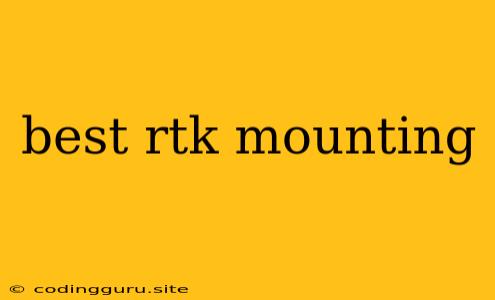Finding the Best R.T.K. Mounting Solution: A Comprehensive Guide
Choosing the right mounting solution for your R.T.K. (Real-Time Kinematic) system is crucial for achieving accurate positioning and maximizing the efficiency of your surveying or mapping projects. The best R.T.K. mount will depend on your specific application, the environment you're working in, and your budget.
What is R.T.K. and why is mounting important?
R.T.K. is a surveying technique that uses a network of ground reference stations and a mobile receiver to determine precise coordinates. It is widely used in various industries, including construction, agriculture, and mining. R.T.K. systems offer centimeter-level accuracy, a significant improvement over traditional GPS methods.
The mount you choose for your R.T.K. receiver plays a vital role in determining the overall accuracy and reliability of your system. A stable and secure mount ensures that your receiver remains stationary and aligned correctly, reducing the chances of signal interference and errors.
Key Factors to Consider When Choosing an R.T.K. Mount:
- Compatibility: Ensure the mount is compatible with your specific R.T.K. receiver model. Each manufacturer may have proprietary designs, so it's important to choose a mount that's specifically designed for your device.
- Stability: The mount should be sturdy and stable, able to withstand vibrations and shocks encountered during fieldwork. Look for materials like aluminum or carbon fiber that are durable and lightweight.
- Adjustability: The mount should offer adjustable height, angle, and orientation to achieve optimal positioning and line of sight for your receiver.
- Versatility: Consider the various applications you might use the R.T.K. system for. A versatile mount can be adapted to different scenarios, such as tripod mounting, vehicle installations, or aerial surveys.
- Ease of use: The mount should be easy to install, adjust, and remove, minimizing setup time and maximizing workflow efficiency.
Popular Types of R.T.K. Mounts:
1. Tripod Mounts:
- Pros: Universal compatibility, lightweight, portable, adjustable height and angle.
- Cons: Not as stable as vehicle mounts, can be affected by wind, requires level ground.
2. Vehicle Mounts:
- Pros: Stable, secure, often integrated with vehicle power systems, allows for on-the-go surveying.
- Cons: Limited adjustability, can be bulky and expensive.
3. Aerial Mounts:
- Pros: Ideal for aerial surveys, can be customized for specific drone models, allows for high-altitude data collection.
- Cons: More specialized, often more expensive than other types of mounts.
4. Pole Mounts:
- Pros: Portable, lightweight, extendable to reach higher positions, ideal for utility and construction projects.
- Cons: Can be less stable than other types of mounts, requires a person to hold the pole.
5. Handheld Mounts:
- Pros: Compact, lightweight, convenient for quick measurements.
- Cons: Limited stability, can be affected by hand movement, not suitable for precise work.
Tips for Choosing the Best R.T.K. Mount:
- Consider your budget: R.T.K. mounts can range from affordable basic models to high-end, specialized solutions.
- Think about your specific applications: Consider what type of surveying or mapping you'll be doing and the environment you'll be working in.
- Read reviews and compare features: Check online reviews and compare the features of different mounts before making a purchase.
- Look for warranty and support: Choose a mount from a reputable manufacturer that offers good warranty coverage and customer support.
Conclusion:
Selecting the right R.T.K. mount is essential for achieving accurate and reliable positioning in surveying and mapping projects. By carefully considering the factors outlined above, you can choose a mount that meets your specific needs and enhances the performance of your R.T.K. system.
